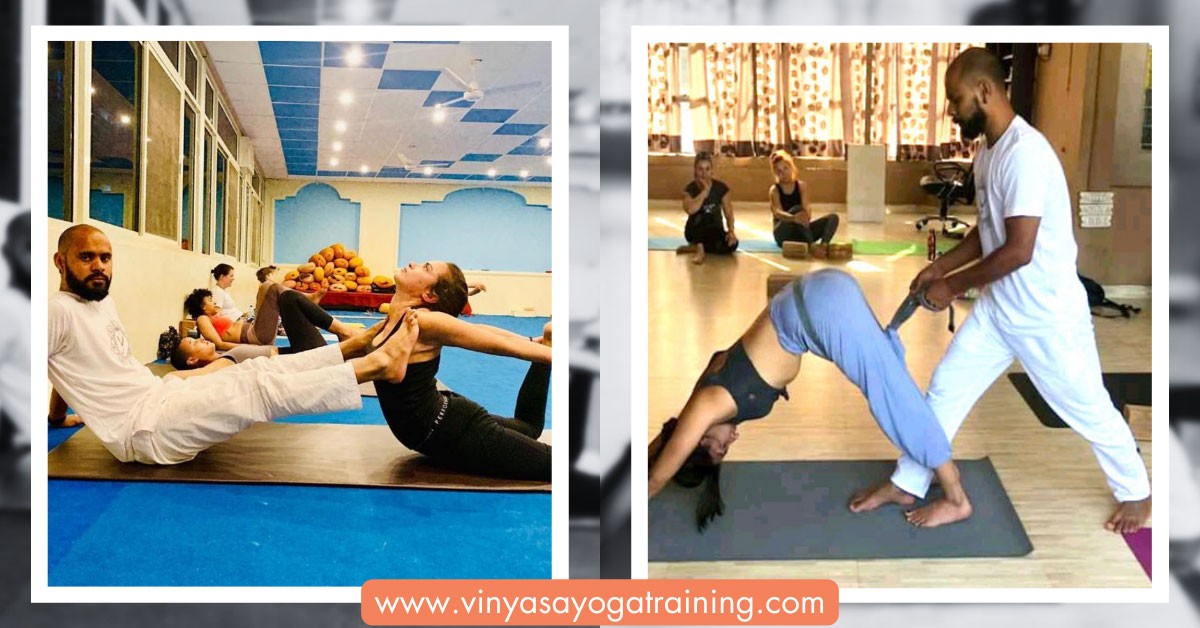Yoga, especially in the serene and spiritually rich environment of Rishikesh, India, transcends mere physical mastery, embodying a journey of growth, learning, and connection. The art of hands-on adjustments forms a vital component of this journey, providing a bridge between teacher and student to deepen the yoga practice. Drawing on key insights from Mark Stephens’ “Yoga Adjustments,” and reflecting the depth of training provided by Yoga Teacher Training programs in India, particularly the Vinyasa Yoga Teacher Training in Rishikesh, this blog explores the seven essential principles every yoga teacher should know for effective hands-on adjustments.
Principle 1: Teach What You Know
Understanding and Experience: The Foundation of Teaching
Yoga Schools in Rishikesh, renowned for their comprehensive Yoga Teacher Training in India, emphasize teaching from a place of personal insight and mastery. This principle encourages teachers to offer adjustments based on poses they deeply understand, ensuring each guidance offered is both safe and beneficial.
In Practice: Knowledge as the Basis of Adjustment
Focusing on asanas with which you are most familiar enhances the effectiveness of your teaching. For instance, when adjusting Downward-Facing Dog (Adho Mukha Svanasana), Start by guiding the student into Adho Mukha Svanasana. Observe their form, focusing on the distribution of weight and the alignment of hips. If an adjustment is needed, approach the student from behind, ensuring they are comfortable with your presence. Place your hands gently on their lower back and guide their hips up and back, encouraging them to deepen their stretch safely, based on your thorough understanding and personal experience of the pose.
Principle 2: Ask Permission to Touch
Consent: The Core of Student Respect
The respectful environment fostered by Yoga Rishikesh is built on obtaining explicit consent before engaging in physical adjustments. This practice upholds the student’s autonomy and comfort, essential for a positive yoga experience.
Implementing Consent
Before making any physical adjustments, it’s crucial to gain explicit consent from the student. This can be done at the beginning of the class or before the adjustment. Approach the student, asking, “May I adjust you?” or use a pre-class consent method like consent cards. This ensures the student feels safe and respected, fostering a positive environment for their practice
Principle 3: Have Clear Intention
Purpose-Driven Adjustments
The Vinyasa Yoga School Rishikesh highlights the significance of having a clear intention behind each adjustment, whether it’s for alignment, deepening the pose, or offering support.
Adjusting Warrior II (Virabhadrasana II)
With the student in Warrior II, observe any misalignment, particularly focusing on the knee’s position over the ankle. Your intention is to aid in aligning the knee properly to avoid strain. Gently guide the knee outward, ensuring it aligns directly over the ankle. This targeted adjustment helps prevent injury and enhances the pose’s benefits, clearly demonstrating your intention to support the student’s wellbeing.
Principle 4: Move with the Breath
Synchronizing with the Student’s Breath
Teaching adjustments in harmony with the student’s breath is a key feature of the Vinyasa Yoga Teacher Training in Rishikesh, emphasizing the fluidity and grace of Vinyasa yoga.
Deepening Forward Fold (Uttanasana)
Instruct the student to enter Uttanasana and observe their breathing pattern. Wait for an exhalation and, with consent, apply gentle pressure on their back to encourage a deeper fold. This adjustment, synced with the breath, allows for a more natural and effective deepening of the pose, highlighting the connection between movement and breath.
Principle 5: Honor Safe Biomechanics
Safety and Understanding
Yoga Teacher Training in India emphasizes biomechanics to ensure safe practice, guiding teachers to make informed adjustments that respect the student’s physical limitations
Supporting Triangle Pose (Trikonasana)
For students struggling with the full expression of Trikonasana, offer a block for their lower hand. Ensure the block is placed in a position that allows their hand, shoulder, and arm to align properly without strain. This adjustment respects the student’s current physical capabilities, promoting a safe and effective practice that honors their biomechanics
Principle 6: Teach Essential Asana Elements
Conveying the Asana’s Essence
Adjustments serve not just for physical alignment but as a tool for imparting deeper asana understanding, integrating the energetic and philosophical elements into teaching.
Enhancing Tree Pose (Vrksasana)
In Tree Pose, beyond physical alignment, focus on teaching balance and concentration. If a student is unsteady, guide them to reposition their standing foot directly under their hip for better support. Encourage them to find a fixed point in front of them (drishti) to focus on. This adjustment helps them understand and experience the deeper elements of balance and focus in the asana.
.
Principle 7: Support Stable Foundations
The Importance of Grounding
Ensuring a stable foundation is paramount, as adjustments aim to solidify the student’s base, enhancing both safety and effectiveness.
Stabilizing in Chair Pose (Utkatasana)
When students enter Utkatasana, notice if anyone’s heels lift off the ground, indicating instability. To correct this, suggest shifting their weight back into their heels. You may also gently press down on their shoulders to guide this shift, ensuring their foundation is stable. This promotes a safer alignment and allows the student to fully engage in the pose with a solid base.
By adhering to these seven principles, yoga teachers, especially those trained in the prestigious schools of Rishikesh, can use hands-on adjustments not only to correct and guide but also to deeply connect with their students, ensuring that adjustments are safe, respectful, and enriching.
Are you ready to transform your life through our yoga teacher training programs? Join our 200, 300, and 500-hour Yoga teacher trainings in Goa and Rishikesh and start your journey towards becoming an experienced teacher today. Learn more and reserve your spot here.


